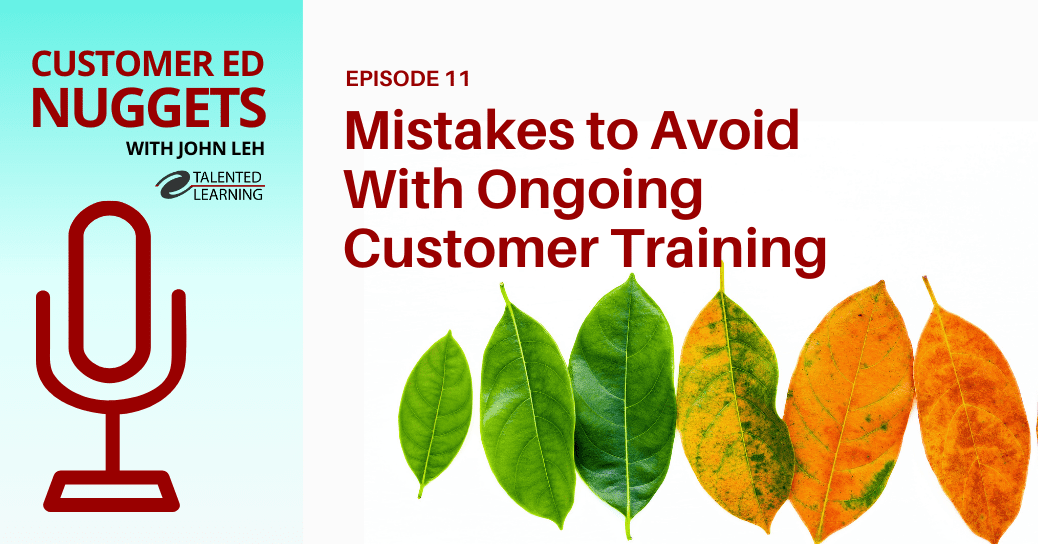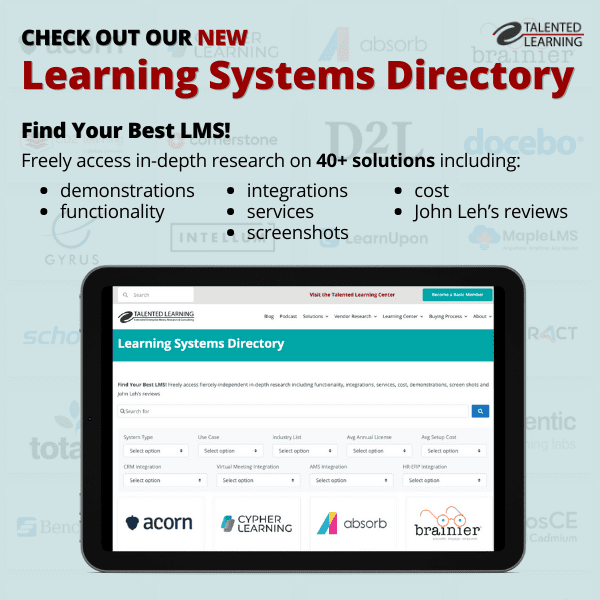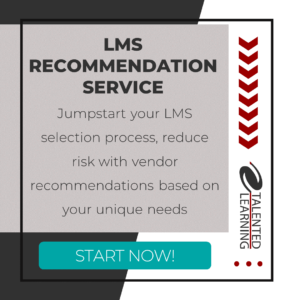
In the post-pandemic era, it will be hard to find a training business that hasn’t reinvented itself through digital transformation. But every organization is carving a different path through this uncharted territory.
This makes sense. After all, every business brings a unique mission and internal DNA to the transformation table. Plus, going digital can be a highly complex, multi-faceted challenge. That’s why you won’t see cookie-cutter learning solutions powering next-generation training products. It’s also why learning systems providers have never faced a richer opportunity to elevate their platforms.
To illustrate, let’s look more closely at strategic considerations that helped two training business innovators transform their offerings and position themselves for continued success in a volatile, uncertain market. Those organizations are CompTIA and Richardson Sales Performance.
A Tale of Two Transformations
At first blush, these companies seem more similar than different:
- Both have moved through recent organizational mergers.
- Both consider high-quality instructional content a mission-critical priority.
- Both have transformed their learning lines of business through forward-thinking digital strategies.
 Nevertheless, each has a unique story and perspective. So let’s revisit conversations I’ve had with leaders at the center of all the action:
Nevertheless, each has a unique story and perspective. So let’s revisit conversations I’ve had with leaders at the center of all the action:
- Ryan Blankenship: Now VP of Product Management at PSI Services, Ryan was previously VP of Product Management and Marketing at CompTIA, where he managed P&L of certifications and learning products and led the teams that developed and delivered digital learning products.

- Chris Tiné: As SVP and Chief Product Officer at Richardson Sales Performance, Chris leads the company’s product development and innovation activities, including global responsibility for content development, data analysis and all digital offerings.
What is your training business mission?
RYAN SAYS: CompTIA is the global leader in vendor-neutral IT certification − primarily qualifying people for in-demand, entry-level jobs. We were founded nearly 40 years ago as a trade association, and for 30 years we focused on certification.
However, as the need for skilled IT professionals began to outpace supply, we added training to expand the qualified talent pool. Now, we have more than 2.7 million alumni, with 200,000 more professionals earning new certifications each year.
CHRIS SAYS: Richardson Sales Performance is the result of a 2020 merger between two successful training business brands – Richardson and Sales Performance International, both of which have been leaders in the sales training space for more than 40 years.
We help large sales organizations simplify their sales growth equation. And we do that by making sure their sales teams develop the right blend of skills and strategic acumen needed for performance that makes a significant contribution to their company’s results.
Do you want deep comparative data on the world’s top 40 learning systems vendors? Check out our 2023 Corporate Learning Systems Market Update report – now available for purchase and download! GET DETAILS HERE
How did you realize it was time to become a digital training business?
RYAN SAYS: About three years ago, we acquired two content companies. That’s when I was brought in because of my background in building learning platforms and content. We were already ahead of the curve in online training and certification, but when Covid-19 hit, we doubled down on digital offerings.
That’s when we introduced digital certification testing through Pearson VUE online proctoring, along with more advanced adaptive training capabilities, so we could offer the best instructional path for each individual.
CHRIS SAYS: As if 2020 wasn’t already crazy enough, we decided to integrate two leading sales training organizations! That gave us a global footprint, a sense of scale and a client list focused heavily on the Fortune 1000.
Several of our clients need to train more than 10,000 people in their sales organization. And with or without a pandemic, scaling that kind of delivery requires a sophisticated digital ecosystem.
What challenges triggered your digital transformation?
RYAN SAYS: Our mission is to help solve the IT skills and jobs gap. And that gap clearly won’t be filled if, year after year, the talent pool is limited only to IT nerds who are already qualified for those jobs. So the question we must ask is, “How can we help more people become successful in the IT profession?”
Certification exams are proof of competence. But it all starts with education. And if you offer great online content, more people will hopefully have more access to better education. So we wanted to up the game for everybody.
CHRIS SAYS: We saw 2 major triggers:
1) Millennials in the workplace
Millennials were rapidly becoming what is now the largest generation in the U.S. workforce. And our clients were increasingly managing a multi-generational employee set. Sales organizations often included four or even five generations. So, to reach these various audiences in a credible way, we needed a whole new level of digital capability. And that need has only accelerated in the last 2-3 years.
2) Demand for a blended approach
Customers and users repeatedly told us that there is real value in facilitated practice. It’s essential for an effective learning experience. But often, the opportunity cost of taking people out of the field for face-to-face classroom training is just too high.
And now COVID has pushed us to the point where travel simply hasn’t been possible. So we’ve had to think about how to scale a blended experience. And that requires a digital learning solution, backed by an integrated digital ecosystem.
What’s your advice for organizations that are stuck in “analysis paralysis”?
RYAN SAYS: For us, the mandate is to create the best quality content, and that means we need to offer a customized learning experience. You can’t control for instructors or for students’ varied backgrounds. But if you have great content, you can scale that across the board.
For us, a customized learning experience is shaped by three considerations:
- Competency: In other words, what’s the specific occupational goal of someone who enrolls in a training and certification program?
- Confidence: Because high exam scores, alone, don’t guarantee mastery of key concepts. To improve job performance, people must also feel confident about applying these concepts in a work context.
- Speed: Ultimately, how can anyone achieve next-level competency and confidence as quickly as possible, based on their existing background, knowledge and skills?
CHRIS SAYS: Probably our most important strategic move was to talk directly with end users. In a training business, it’s very easy to think of your customer as the person who signs the contract. But what about the person who must sit through 12 hours of online learning to earn a certification?
Understanding what it takes to be credible from that person’s perspective is essential. What exactly will it take to surprise and delight that end user?
Understanding the end user gave us the ability to reach individuals and genuinely change their behaviors. In turn, these new behaviors reach across the sales organization and eventually cascade into overall business impact.
What success metrics do you recommend?
RYAN SAYS: We know that the train-to-test ratio in the IT space is about 5:1. So among other things, we built a ratio between content sales and our certifications so we can measure how successfully we’re penetrating the market, compared with that benchmark.
We also look for certification mentions and mandates in job descriptions. Plus, our research team studies the job performance of people with certifications. Are they promoted faster than others? Do they stay in positions longer? We analyze those trends.
But for us, success is not about how many hours someone spends training. It’s actually how quickly they attain competency.
On the other hand, we need to remember that IT isn’t simple. There are no shortcuts. And we don’t want to overinflate an individual’s sense of mastery. So it’s important to balance necessary education and skills development with convenience and terrific content. That’s why we offer adaptive learning and hands-on virtual labs.
Do you want deep comparative data on the world’s top 40 learning systems vendors? Check out our 2023 Corporate Learning Systems Market Update report – now available for purchase and download! GET DETAILS HERE
How did you take content to the next level?
CHRIS SAYS: Here are 3 points to consider:
1) Above all, recognize that content is not an all-or-nothing game.
I often hear people say, “We’ve got this enormous library of ILT content. How do we get all of this online fast?” But maybe you don’t need all that. Maybe you can do it with a smaller footprint or in ways that are more efficient. It’s an unbundled world now. Maybe you can deconstruct long-form content into forms that are easier to deliver and digest.
You’ll have better results if you start with a clear idea of the skills you want to teach and the behaviors you want to change. Be clear about the outcomes you want to achieve. Then focus on content that will help you accomplish that outcome.
2) Think about how to make your content more engaging and credible.
Every salesperson wants to get better at what they do because it will have a direct impact on their earnings and on business revenue. So they’re internally motivated to take training seriously. They want to learn so they can be more successful.
But if training content doesn’t feel credible, it’s unlikely that you’ll get buy-in or convince learners to apply those skills. And nothing makes training more unappealing than feeling like it’s out-of-date or cheesy. Frankly, things like clip art animations just don’t feel credible in a business context.
But video can bring instant credibility and engagement to online skill development. And neuroscience research says that watching someone engaging in a skill can help us practice and learn more efficiently.
So for us, video plays a powerful role in helping our remote learners connect the dots as they envision themselves applying various skills.
3) Think carefully about how to “chunk” content
Speaking of video content, engagement research indicates that video attention begins to taper-off after about 2.5 minutes. So a 2-5 minute span is kind of our sweet spot. That doesn’t mean that every lesson must be between 2-5 minutes long. But think of ways to re-engage learners every few minutes with another activity. Ask a question, share a pop-up fact, point to a game. Keep them moving forward with you.
How do you connect the dots between content and user experience?
RYAN SAYS: A modern user experience and adaptive capabilities are vital for us. Our learners bring diverse levels of IT experience to the process. So a one-size-fits-all learning experience won’t work.
For example, network engineers who need to qualify for a promotion or contract work may already know 80% of certification exam material. They shouldn’t have to study for 40 hours before taking the next step. Instead, they should be able to bypass topics they’ve mastered and fast-forward to subjects that require more study and proficiency.
Meanwhile, other learners have had very little IT experience. They may be career changers or veterans. Or maybe someone is just tinkering at home, setting up a Wi-Fi network, and wants to learn more. That person needs much more time to develop basic skills. In that scenario, adaptive learning is just as important. Everyone has a unique background.
What factors influenced your learning platform choice?
RYAN SAYS: The learning platform world is vast and you don’t want to over-buy or under-buy. It’s easy to make a mistake by going with a well-known name that just doesn’t fit you and your customers. You and most of your learners will probably only use 20% of the platform functionality. So keep it simple at first, especially if you’re looking for speed.
But if you’re committed to a digital training business, you can’t expect to just plop your classroom experience into an LMS. The result won’t be successful because the learning experience will feel static.
That said, you’ll probably want an HTML5 browser-based LMS that includes LTI integration, because some of the more complicated content may have to come from third parties. It’s also important to consider the clients your training business serves. Are you re-selling this to training partners and academic institutions? Or is your audience primarily B2C?
We use BenchPrep because, among other strengths, it has great inline assessment capabilities. This lets you offer a blended mix of content along with assessments, so learners don’t get bored. You can also set the date for your certification exam to automatically build a custom learning plan, which is helpful in a variety of situations.
But every organization is different. I recommend building a requirements document based on your product strategy and customer needs, so you have a rubric to help filter learning platforms in or out of your decision set.
CHRIS SAYS: The product you’re bringing to market is a combination of your content and the technology you use to deliver it to create a learning experience for your user. And from a technology perspective, I think three things have become table stakes:
1) Dynamic content management
Gone are the days of pre-authored elearning chunks or passive content bundles. Today’s systems should have tagging capabilities that let you combine small content pieces on the fly, in whatever ways a learning experience requires.
2) Assessment components
Do you have an integrated assessment strategy? And does your platform let you marry small pieces of content? (For example, can you connect a video, a brief lesson, or a piece of content with one or two assessment questions? This transforms a static 30-40-question assessment into a more dynamic set of smaller in-line learning experiences.)
3) Technical performance
People tend to forget this, but a rock-solid, reliable platform lets you deliver a consistent experience every time, in every location. This is especially important for global players.
But going beyond table stakes, I would ask you to think about what will differentiate your product. And that should come from a meaningful training experience that doesn’t just feel like everything else.
Think about flashcards. Think about gamification. Think about encouraging competition among learners with a leader board. Think about pairing people into cohorts to discuss topics in a forum or another social setting.
There are many possibilities and you don’t need to adopt all of them. But think about what will genuinely surprise your users, and give them a fresh lens on the experience. That should lead to successful results.
Conclusion
Wow. So many valuable insights from these two experts! Perhaps the most critical takeaway is the familiar reminder that content is king. But not necessarily ALL content.
When kickstarting digital transformation, it’s tempting for organizations to bite off more than they can chew. That doesn’t serve anyone well. Smart training business leaders know that speed and agility are the key, and trying to do everything all at once will probably only cause the effort to implode from its own weight.
Instead, take sufficient time to clarify your priorities upfront. Then build a digital strategy around the top priority. The rest will follow.
If you want more details from these experts, I invite you to join our Talented Learning Center research and education portal as a premium member, and replay the webinars featuring Ryan and Chris:
- How to Move Certification Online, Fast!
(with Ryan Blankenship and Ashish Rangnekar of BenchPrep)
- 6 Dimensions of Digital Training Transformation
(with Chris Tine and Ashish Rangnekar of BenchPrep)
You’ll also find dozens of other useful on-demand webinars, along with a growing library of other resources to help you find and optimize your organization’s learning systems.
Thanks for reading!
Need Help Buying the Best LMS for Your Training Business?
Talented Learning is now in its 10th year of researching the LMS market and helping modern LMS buyers find the best LMS based on their unique needs. From hourly help to full-service solutions, Talented Learning helps modern LMS buyers jumpstart their selection process, reduce time and minimize risk. Fill out the form below for a complimentary discussion with lead analyst John Leh.
Share This Post
Related Posts
The Future of Customer Education: Customer Ed Nugget 16
Customer education is rapidly evolving as organizations embrace new strategies and tech. What does this mean for the future of customer education? See what experts say on this Customer Ed Nuggets episode
Education Strategy Mistakes to Avoid: Customer Ed Nugget 15
What does it take to deliver a successful customer education program? It starts with a solid education strategy. Learn how to avoid common pitfalls on this Customer Ed Nuggets episode
Which LMS is Best for You? New Shortlisting Tool for 2024
How can you find the best learning system for your business? Our LMS shortlisting tool can help. Learn about the 2024 RightFit Solution Grid. Free, reliable guidance based on our independent research
How to Build a Learning-Based Business: Executive Q&A Notes
Building and selling online courses may seem easy, but building a profitable learning-based business is far more complex. Find out what successful leaders say about running this kind of business
The Rewards of Community Building: Customer Ed Nugget 14
What role does community play in your customer relationships? Find out why community building is such a powerful force in customer education on this Customer Ed Nuggets episode
Benefits of Training Content Syndication: Customer Ed Nugget 13
If you educate customers online, why should you consider content syndication? Discover 10 compelling business benefits in this Customer Ed Nuggets episode
Top Marketing Skills to Master: Customer Ed Nugget 12
Successful customer education programs depend on professionals with expertise in multiple disciplines. Which marketing skills lead to the best results?
How to Measure and Improve Partner Training ROI
An educated channel is a successful channel. But how do you know if your educational programs are effective? Learn from an expert how to evaluate partner training ROI
Mistakes in Ongoing Customer Training: Customer Ed Nugget 11
Customer education doesn't stop with onboarding. It pays to invest in ongoing customer training. Learn which mistakes to avoid in this Customer Ed Nuggets episode














FOLLOW US ON SOCIAL